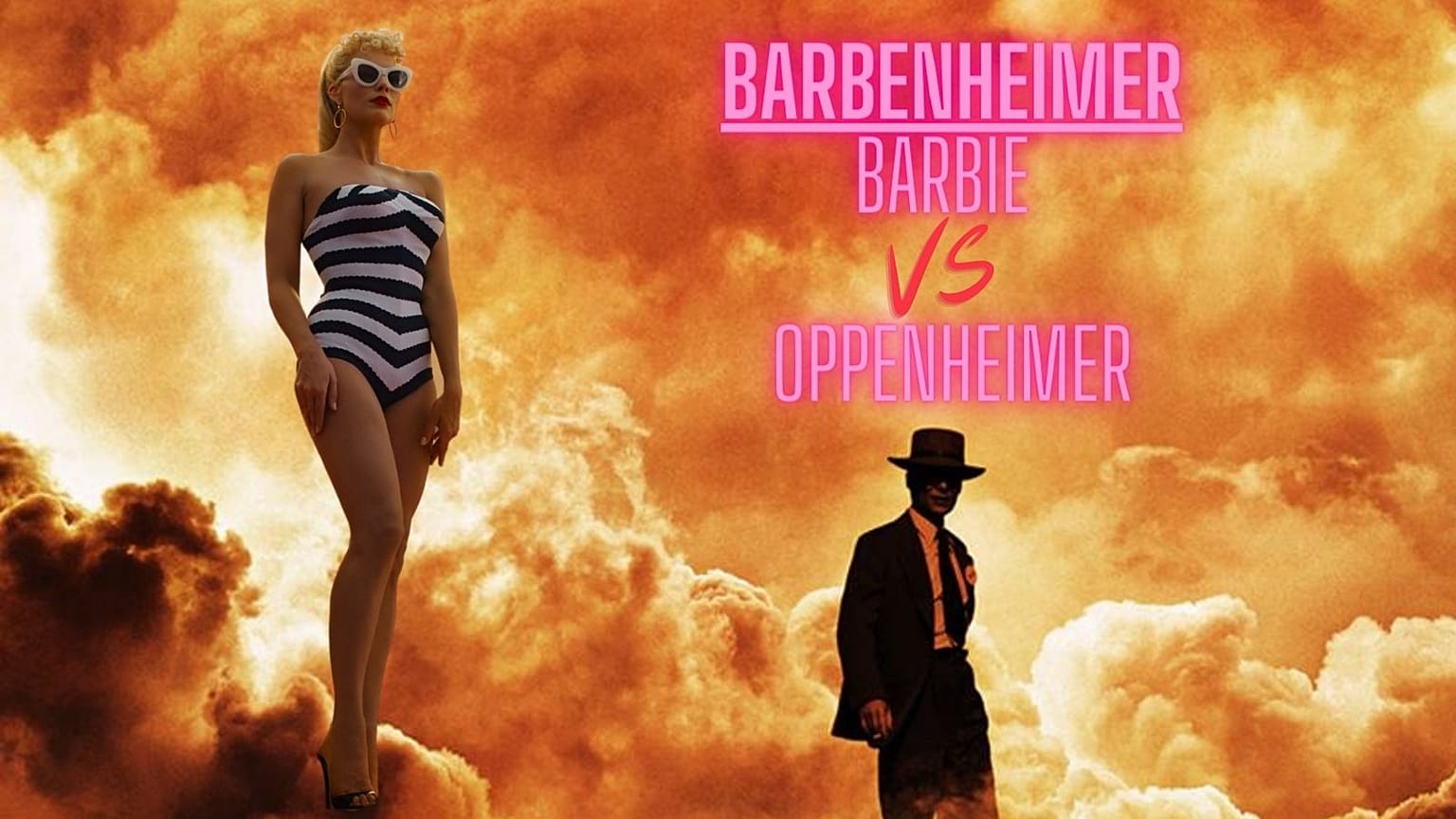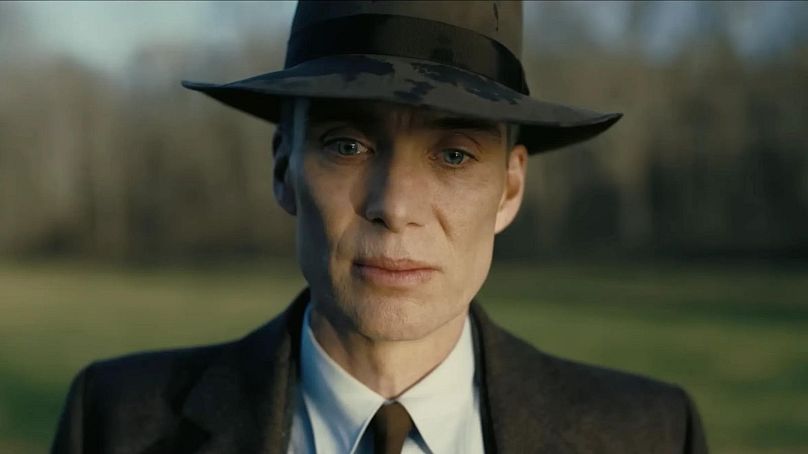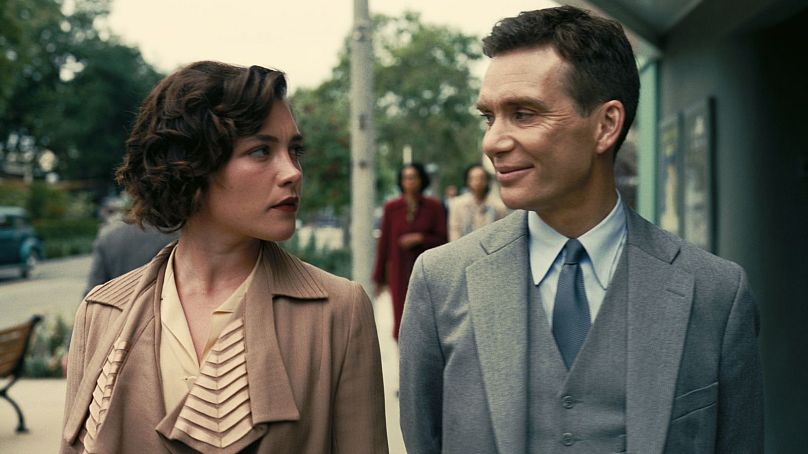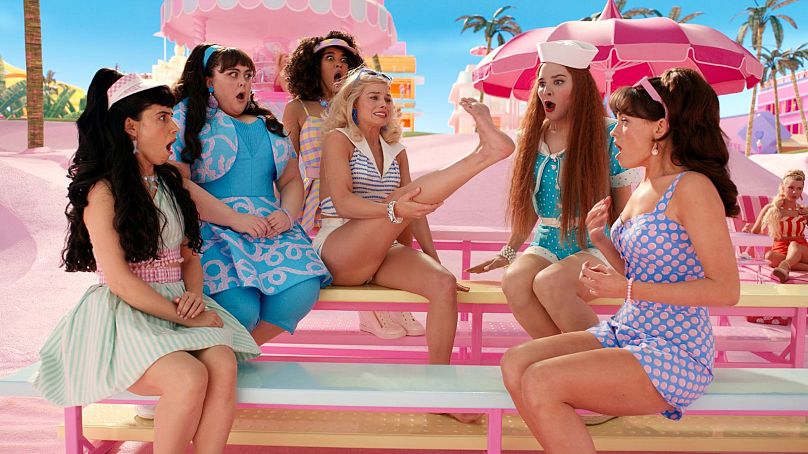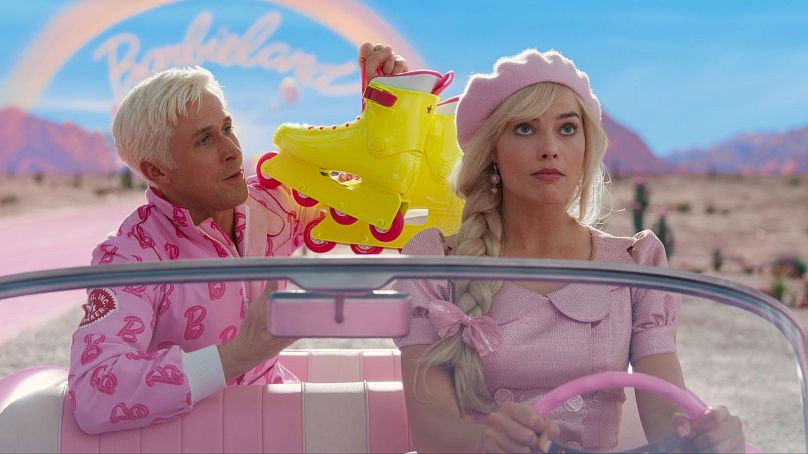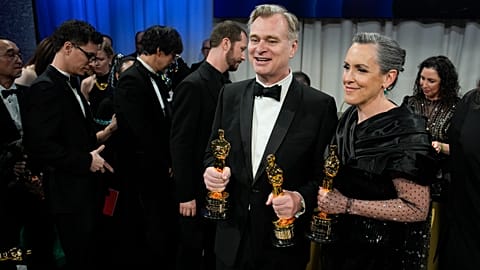Now I am become Barbie, the destroyer of Kens.
It's the epic moviegoing battle of the year.
So much so that both films are better known as under the portmanteau 'Barbenheimer'.
Unless you've been living under a rock, you'll know that Barbie and Oppenheimer have been pitted against each other in cinemas on the very same day, a clash of the titans not seen since 1999, when The Matrix opened alongside the seminal classic 10 Things I Hate About You.
Who will be the victor? Read on to find out.
We start in the order in which this strange double-bill should be watched, lest ye be branded a sociopath...
Based on Kai Bird and Martin J Sherwin’s non-fiction book ‘American Prometheus: The Triumph and Tragedy of J. Robert Oppenheimer’, Christopher Nolan’s new film gives us an exhaustive look at the rise and fall of the theoretical physicist who oversaw the Manhattan Project and introduced nuclear weapons to humanity.
Because this is a Nolan joint, don’t expect anything too linear or easy. The story plunges you into a crowded field, and it’s your job to keep up. No dates, locations or handy character nametags will guide you along the way – only info-heavy dialogues which often discuss theory versus practical and probability versus certainty. Mercifully, the script does not demand of the audience to wrap their heads around the actual quantum physics, much like the dire Tenet required audiences to wrestle with its noodlebaking and poorly handled sci-fi conceit.
What we do get are two parallel and oscillating narrative timeframes, titled “Fission” and “Fusion”. The first is in colour; the second in black and white. We track Oppenheimer (Cillian Murphy)’s rise through academia which leads him to eventually helm the Manhattan Project, interspersed with hearings in which an older Oppenheimer deals with the fallout of his discovery and is suspected of having ties to Soviet Communism. The third storyline (the monochrome courtroom drama) introduces us to Lewis Strauss (Robert Downey Jr.), the head of the Atomic Energy Commission up for a cabinet post in Dwight Eisenhower’s second administration, whose connection to Oppenheimer gradually becomes clear...
Dizzy yet? What else do you expect from the director who hasn’t found a story he can’t chronologically fracture?
There’s no denying there is a lot of movie here. Thankfully, Nolan’s beloved nonlinear approach doesn’t feel like a directorial hallmark-gone-gimmicky, and the film benefits from this fragmented chronology. It can be frustrating, as the film cuts between timelines that offer a character study, a courtroom procedural and a McCarthyism thriller. However, with the invaluable help of editor Jennifer Lame, Nolan gradually builds up to a third act that puts the rest of the film in perspective. A less twisty and ‘neater’ film would not have conveyed the equally twisty moral disposition that comes with discovering a humanity-changing weapon quite so harrowingly.
The huge ensemble cast is one of Nolan’s most impressive casting coups – with some surprising cameos. At the centre of it all is Cillian Murphy, who gives a compelling and transformative performance as Oppenheimer, one which echoes (in a more restrained way) what Daniel Day-Lewis achieved in There Will Be Blood. He brilliantly transmits the character's passion for discovery as well as conjure a wealth of conflicting emotions simmering beneath the surface of a complex man, one who is praised as the figure who ended the war but who is rattled with guilt over the destructive legacy he leaves behind. Through Murphy’s (soon-to-be awards nominated, count on it) haunted blue eyes, you understand the appeal of martyrdom in order to cleanse one’s sense of guilt, as well as embrace the fact that Oppenheimer is, at its core, a horror story based on a haunting.
As uniformly stunning as the film is on a visual level – courtesy of cinematographer Hoyte Van Hoytema – one sequence stands out when this haunting manifests itself on screen.
Following the Trinity test and just after the bombs have been dropped on Hiroshima and Nagasaki, we’re inside Oppenheimer’s head as he addresses his fellow scientists. His nightmarish visions begin to bleed into real life. The hallucinations of burnt corpses and empty bleachers are measured and never overplayed, delivering one hell of a gut punch. The scene also features a masterful command of silence, contrasting with Ludwig Göransson’s foreboding score. For all the bombastic Hans Zimmer horns in Inception and the questionable sound mixes of Interstellar and Tenet, Oppenheimer shows that Nolan may have understood that he doesn’t need to cackhandedly rely on an overwhelming score to ensure emotional involvement. He shrewdly relies on the visceral and oppressing power of well-timed silences to make certain scenes unforgettable and chilling in the extreme.
This anxiety-inducing hallucinatory scene in particular also quashes the critique that Oppenheimer fails to address the invention of the A-bomb from a Japanese perspective. Beyond the fact that the film is based on the American inventor and we follow this perspective throughout, the haunting sequence manages to unnervingly communicate the bomb’s real-world effect by creating a terrifying vision of all-American smiles and cheers morphing into harrowing wails. The horrors are not ignored, and neither is a stealthy critique of American exceptionalism – and later on, the commentary on how the US, specifically the bureaucrats and politicians in charge, chew those who perform their function in the name of loyalty and service to their country before spitting them out once the job is done.
If there is one glaring flaw with Oppenheimer, it is a longstanding issue with Nolan: the man has a hard time when it comes to women.
Emily Blunt and Florence Pugh do their best with underwritten roles as, respectively, Oppenheimer’s tipsy wife Kitty and his former troubled lover and Communist activist Jean Tatlock. Both characters serve an important purpose and Blunt does manage to briefly steal the show in the final act when she stands up for her husband during a rigged security hearing. However, Nolan’s inability to write complex roles for women remains alive and well.
We do have a Nolan first here: a sex scene with *gasp* nudity. However, it becomes unintentionally laughable and explains why the director’s filmography has been largely sexless until now. In Nolan’s version of events, Pugh’s topless Jean hands Oppenheimer the famous Sanskrit poem from the Bhagavad-Gita that would infamously become his response to the Trinity test: “Now I am become Death, the destroyer of worlds”. As she straddles him on the bed, the text is held open against her bare chest. It’s an odd choice, and the less said about the naked visions during an interrogation scene, the better.
Nolan is clearly more comfortable giving screen time to the men in his life (Kenneth Branagh, Josh Hartnett, Benny Safdie, Rami Malek, Dane DeHaan and a scene-stealing Matt Damon as General Leslie R. Groves) but considering there are only two women with meaningful screen time, it’s a damn shame either of them feel fully fledged or in any way separate from their romantic connection to our main protagonist.
While imperfect and at times very unwieldy, Oppenheimer remains a technically masterful American tragedy and an overpowering biopic about the judgement of history, one that towers above its genre neighbours. To quote the film, “it’s paradoxical and yet it works.” It may even be a contender for Nolan’s best film, alongside The Prestige. Maybe he needs to stick with men who build machines which destroy lives... And no more sex please, Christopher. Your idea of foreplay is about as existentially terrifying as the nuclear arms race Oppie triggered.
Let’s move on to Barbie, which features a director, Great Gerwig, who can flesh out female characters – even if they’re originally made from plastic.
Hardly a seamless transition, but it’s Kenough.
Helen Mirren’s arch narration sets the scene.
The residents of Barbie Land have solved "the problems linked to feminism”: like Barbie, women can be anything. Each day in Barbie Land is “the best day every day”, filled with rictus greetings, delightful but mechanically-challenged car rides, and trips to the beach.
This bliss is shattered when Stereotypical Barbie (Margot Robbie) starts experiencing malfunctions. Her feet are suddenly flat. Her thighs develop cellulite. And during a Dua Lipa dance number one evening, she starts having some intrusive thoughts. Like J. Robert Oppenheimer, Barbie has death on the mind and is plagued by it.
These two films really do merit a double bill.
Her awakened existential angst leads Barbie to set off to the Real World with clingy Ken (Ryan Gosling), who leaves behind his job as “beach” (he’s not a lifeguard, we’re told, as many mistakenly presume), to track down Gloria (America Ferrera) and her surly tween daughter Sasha (Ariana Greenblatt), who may be behind the malfunctions. However, little do they know that they’re travelling to a world where sexism has not been solved. Far from it. As if that wasn’t enough, Mattel’s (male) corporate bigwigs (led by Will Ferrell) learn of their journey of self-discovery and set out to put Barbie back in her box, while Mr. Blonde Fragility gets a bit too comfy in his newfound surroundings and chooses to soothe his insecurities by embracing the patriarchy. Worse, he’s bringing it back as a contaminant to Barbie Land.
Alongside Matchbox Twenty’s hit ‘Push’.
What works in this meta-spectacle works wonders. It’s not the lazy mash-up of Enchanted and The Lego Movie that it seemed initially, and both Robbie and Gosling are terrific. Most impressively, what could have been a committee-commissioned corporate trap to sell toys under the guise of self-awareness is actually far weirder than anyone could have expected. The strange moments and visual gags are often laugh-out-loud funny, at times downright surreal.
It’s still a toy movie, mind you, but a satirical one that somehow manages to have its pink cake and eat it too. Gerwig, who co-wrote Barbie with her partner Noah Baumbach, leans into the image of the (in)famous doll and asks whether she is a force for good or simply the totem of sexualised capitalism peddling impossible expectations. The way the script wrestles with this contradictory dichotomy is fascinating – avoiding easy hectoring (for the most part) and refusing for Barbie to turn into a vapid '#GirlBoss – The Movie' about all men being uniformly rubbish. The film surprisingly tackles heavy questions with both humour and nuance, and while some moments lay it on a bit thick, the message remains focused. And hats off to a filmmaker who can take a figure that can rebrand as inclusive all she wants but she's still a weak vessel for empowerment (and even less a feminist icon), subvert Hollywood’s typical eye-rolling attempts at feminism, and manage to lovingly craft an entertaining blockbuster that uses that same problematic figure to say something about gender roles in today’s society.
Again, much like Oppenheimer, there are blemishes along the way.
Beyond the upcoming onslaught of think pieces that will pseudo-intellectually tear the film apart in every direction, and a soundtrack which does fall neatly into the crass category of cynical exercise in branded tie-ins, yielding precious little except providing very talented artists like Haim and Dua Lipa a big fat cheque for songs that wouldn’t have been considered for an album inclusion on even a bad day, the main offender isn’t actually in the movie.
The film’s expansive marketing blitz – which has literally pinkwashed the world with its countless brand partnerships and become an increasingly tiresome example of the shameless capitalist hellscape we live in – has been both a blessing and a curse for Barbie. While we can all joke that “it’s Barbie’s world, and we’re just living in it”, there's another problem when the teasers, trailers and online clips released prior to the film’s rollout spoil most of the best parts.
The most disappointing example of this is Barbie ’s terrific opening, an homage to Stanley Kubrick’s 2001: A Space Odyssey which casts Barbie as the enigmatic monolith. It’s a terrific gag and should have made it the opening sequence of the year. But instead of announcing the weirdness ahead (and provoking much laughter), everyone had already seen the sequence, as it was essentially the entirety of the teaser trailer. It’s understandable as the studio were keen to make it perfectly clear that Barbie wasn’t going to be your average cash grab. However, had they dialled it down a bit, without taking Studio Ghibli’s refreshingly minimalist and intrigue-preserving mystery-driven 'marketing' for animation legend Hayao Miyazaki’s most recent film How Do You Live? (retitled The Boy and the Heron), then a great many gags would have had more impact and felt fresh. As it stands, by the time you see Barbie, you’ll have essentially been drip-fed many of the jokes.
Still, it’s to Gerwig and co.’s credit that they’ve managed the impossible by delivering a deeply bizarre and often hilarious take on the patriarchy through a brand that is inseparable from its consumerist origins. No mind-numbing expansive marketing campaign can completely damage that. Sequels could though, so enjoy it while it lasts.
So, when all’s said and done, who emerges victorious in the movie clash of the year?
Both do. They're not only worth your time but a surprisingly effective double-bill. Muster all the Ken-ergy you can, get yourself to the talkies, and rejoice that after a series of crushingly disappointing high-profile 2023 releases (Asteroid City, Indiana Jones and the Dial of Destiny, Mission: Impossible – Dead Reckoning Part One, to name the most recent offenders), you can circle 21 July on your calendars as the date Oppenheimer and Barbie saved the blockbuster year.
Both Oppenheimer and Barbie are out in cinemas worldwide today.















